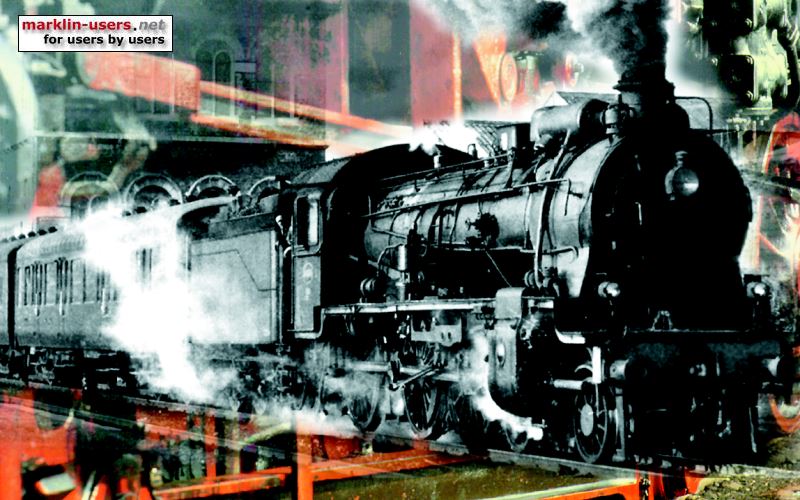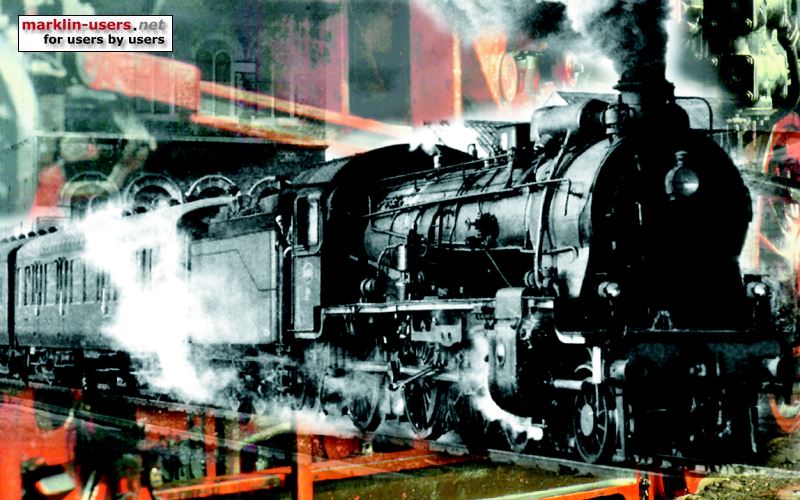marklin-users.net community | Forum
»
General topics
»
H0-scale
»
Similarity of 37020 and 37023 freight steam locomotives; how does condensation tender work?
 Joined: 14/11/2003(UTC) Posts: 1,443 Location: Northeast Ohio
|
I was regretting not ordering the Club anniversary 37020 freight steam locomotive with a condensation tender. Then I looked at my Marklin engines (temporarily in storage) and discovered I have a 37023 loco whose engine looks identical to the 37020 except the tender is not a condensation tender with the fans etc.
Any of you have the 37023 and opted to order the anniversary model (37020)? If so, what were your reasons?
What is the purpose of the condensation tender, how does it compare to the conventional tender and did it fall into disfavor for some reason?
Thanks,
Larry
|
|
|
|
|
|
Joined: 16/02/2004(UTC)
Posts: 15,467
Location: DE-NW
|
Hi! Originally Posted by: Larry  What is the purpose of the condensation tender, how does it compare to the conventional tender and did it fall into disfavor for some reason? Typically the operating range of steam locomotives is limited by water. Condensation tenders are one way around that problem. During war times they also reduce the visibility of steam locos (as steam is "recycled" and not ejected). Typically steamers can run 300 km with a full tender - enough for a small country like Germany. In South Africa, condensing tenders were used much longer. In the USA and France, some steam locos took fresh water while driving - a simpler technique (less maintenance) to increase their range. Edited by user 10 May 2013 07:59:53(UTC)
| Reason: Senior's moment |
Regards Tom --- "In all of the gauges, we particularly emphasize a high level of quality, the best possible fidelity to the prototype, and absolute precision. You will see that in all of our products." (from Märklin New Items Brochure 2015, page 1) ROFLBTCUTS  |
 3 users liked this useful post by H0
|
|
|
|
 Joined: 15/03/2003(UTC) Posts: 9,614 Location: Australia
|
Originally Posted by: H0  ..Typically steamers can run 300 km/h with a full tender... Yikes!  Why did we need a Thayls if steamers can go that fast? |
Adrian Australia flag by abFlags.com Australia flag by abFlags.com |
|
|
|
|
|
 Joined: 22/01/2009(UTC) Posts: 14,879 Location: On 1965 Märklin Boulevard just around from Roco Square
|
Originally Posted by: xxup  Originally Posted by: H0  ..Typically steamers can run 300 km/h with a full tender... Yikes!  Why did we need a Thayls if steamers can go that fast? because they're not called steamers  |
|
|
|
|
|
|
 Joined: 14/11/2003(UTC) Posts: 1,443 Location: Northeast Ohio
|
Thanks, Tom, for sharing your great insights. I greatly appreciate it.
Larry
|
|
|
|
|
|
Joined: 16/02/2004(UTC)
Posts: 15,467
Location: DE-NW
|
Originally Posted by: xxup  Originally Posted by: H0  ..Typically steamers can run 300 km/h with a full tender... Yikes!  Why did we need a Thayls if steamers can go that fast? My fault - corrected. |
Regards Tom --- "In all of the gauges, we particularly emphasize a high level of quality, the best possible fidelity to the prototype, and absolute precision. You will see that in all of our products." (from Märklin New Items Brochure 2015, page 1) ROFLBTCUTS  |
 2 users liked this useful post by H0
|
|
|
|
 Joined: 14/03/2005(UTC) Posts: 15,871 Location: Gibraltar, Europe
|
Originally Posted by: H0  Hi!
....
In the USA and France, some steam locos took fresh water while driving - a simpler technique (less maintenance) to increase their range.
This was done on the main lines in the UK as well, and I always thought the idea was very cool. It works by having a trough between the rails full of water, and a scoop under the tender that can be lowered into the trough. As this is done at speed the water is scooped into the tender under considerable pressure, filling it in seconds. It must have been spectacular to see! |
Ray
Mostly Marklin.Selection of different eras and European railways
Small C track layout, control by MS2, 100+ trains but run 4-5 at a time.
|
 2 users liked this useful post by RayF
|
|
|
|
 Joined: 25/08/2012(UTC) Posts: 255 Location: South East
|
That's right. There were water troughs on most of the main lines in the UK, I think they were about 1/4 mile long. They could pick up a couple of thousand gallons in about 15 seconds! Apparently it took a huge amount of strength to wind the scoop back up against the force of the water. It had to be done quickly too as if the tender overflowed the front coach would get deluged in water. Not a problem in the winter but in the summer some of the windows would be open...  Even some of the early diesels had water scoops fitted to replenish the water tank that fed the steam heating boiler. Paul |
Marklin HO using M track. Now reverted to analogue as I find it has more character and is more fun...... and I understand it! |
 1 user liked this useful post by Paul59
|
|
|
|
 Joined: 20/01/2006(UTC) Posts: 571 Location: Kirkcaldy, Fife
|
Condensing tenders were developed during World War 2, by Germany for use in Russia where there were problems with adequate water supplies. The exhaust steam is diverted back into the tender where it is passed through an array of tubes, cooled by air fans. In place of the steam exhausting up the chimney a fan provided the draught to the fire. This could cause problems with steaming as the automatic feedback between the rate of working and the amount of energy being produced is lost. As a normal locomotive works harder, more draught is generated in the smokebox which increases the rate of combustion. On top of which of course is the greatly increased weight and complexity of condensing tenders.
Around London, condensing tank engines were used in tunnels. However here the steam was simply diverted into the side tanks. Eventually the water would get so hot that the injectors would stop working. At that point the water in the tanks would be dumped and replaced with cold water.
Bob M.
|
 1 user liked this useful post by rmsailor
|
|
|
|
 Joined: 25/09/2010(UTC) Posts: 417 Location: Sherwood Park, AB, Canada
|
Condensation tenders were also hard to maintain. The theory of recycling the water is great but between the mechanisms and the corrosion, they were hard to maintain. I would like a condensation lok just for the engineering curiosity. |
Harald
CS2 DB & Canadian Era 3-6 |
|
|
|
|
|
 Joined: 02/01/2009(UTC) Posts: 1,067 Location: Auckland, New Zealand
|
With all steam ships and power plants having condensors, I would have thought they had the problem of corrosion sussed. I suspect that the problem on applying them to locos was that tenders tend to vibrate and jerk, stressing parts of the condensor, and the sheer weight of it all. Any extra weight in the tender you add means less tonnage and therefore money you can move. The artificial draught is a problem as well, how to get the draught going without excessive wear on the machinery. Also, it may seem odd, but the pulsing draught makes a steam boiler steam much better than a continuous draught.
My two cents worth,
Rick
|
|
|
|
|
|
Joined: 16/02/2004(UTC)
Posts: 15,467
Location: DE-NW
|
Corrosion was a big problem with the Franco-Crosti design, but a quick search on google found no articles about corrosion problems with condensing tenders (no exhaustion fumes involved). |
Regards Tom --- "In all of the gauges, we particularly emphasize a high level of quality, the best possible fidelity to the prototype, and absolute precision. You will see that in all of our products." (from Märklin New Items Brochure 2015, page 1) ROFLBTCUTS  |
|
|
|
|
|
 Joined: 19/09/2009(UTC) Posts: 841 Location: Lidingö, Sweden
|
Originally Posted by: Paul59  That's right. There were water troughs on most of the main lines in the UK, I think they were about 1/4 mile long. They could pick up a couple of thousand gallons in about 15 seconds! Apparently it took a huge amount of strength to wind the scoop back up against the force of the water. It had to be done quickly too as if the tender overflowed the front coach would get deluged in water. Not a problem in the winter but in the summer some of the windows would be open...  Even some of the early diesels had water scoops fitted to replenish the water tank that fed the steam heating boiler. Paul Couldn't there have been problems also in winter sometimes? I guess there is a reason why this method was never used in Sweden. Think: Temperature below 0 C or 32 F. 
|
|
|
|
|
|
marklin-users.net community | Forum
»
General topics
»
H0-scale
»
Similarity of 37020 and 37023 freight steam locomotives; how does condensation tender work?
Forum Jump
You cannot post new topics in this forum.
You cannot reply to topics in this forum.
You cannot delete your posts in this forum.
You cannot edit your posts in this forum.
You cannot create polls in this forum.
You cannot vote in polls in this forum.